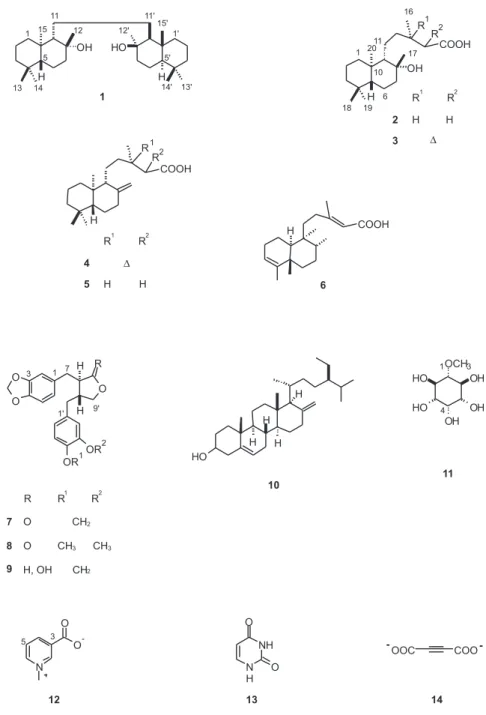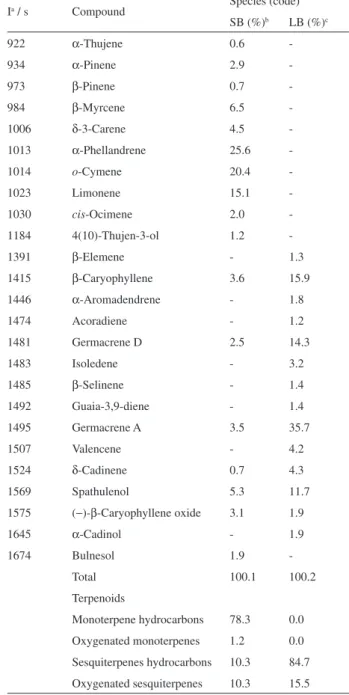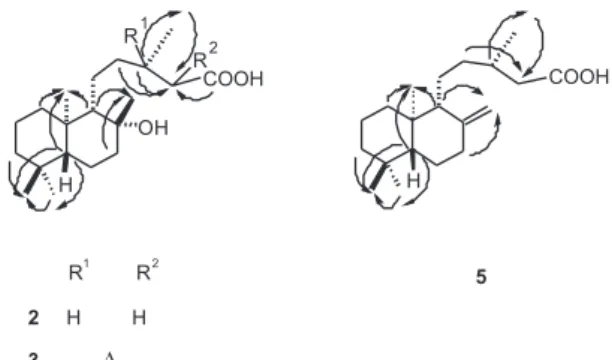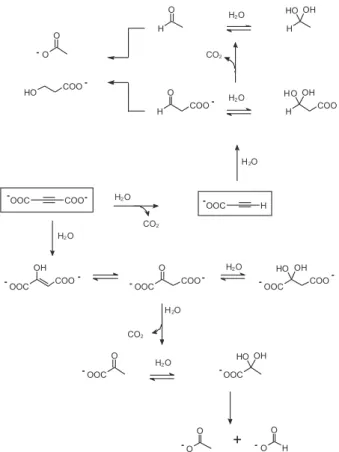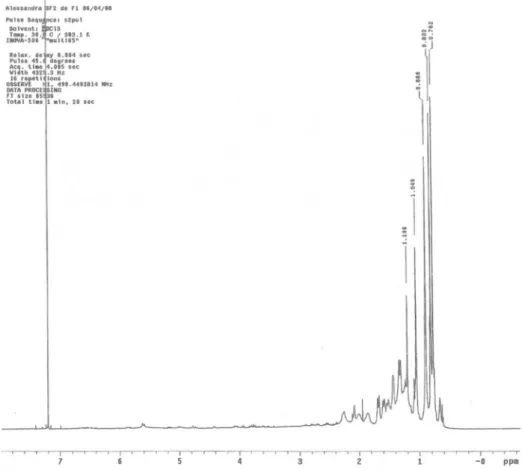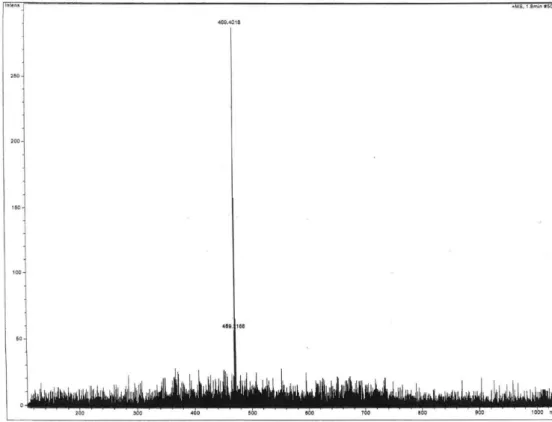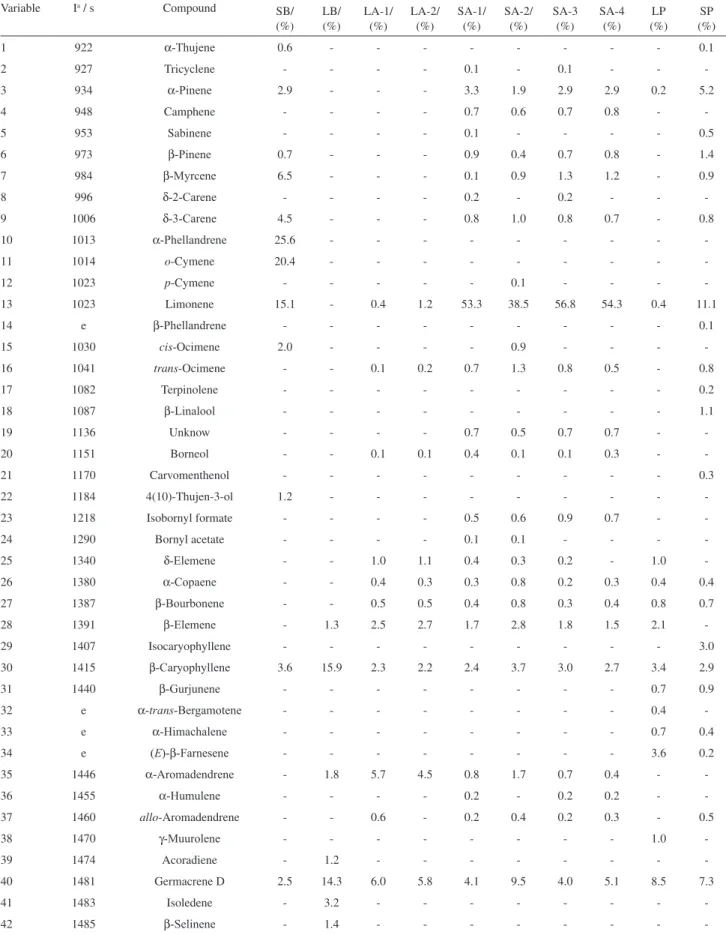Article
0103 - 5053 $6.00+0.00
*e-mail: lopesxl@iq.unesp.br
Chemical Constituents of
Aristolochia giberti
Alessandra M. Marchesini, Giovana G. Prado, Gisele B. Messiano, Marcos B. Machado and Lucia M. X. Lopes*
Instituto de Química, Universidade Estadual Paulista, CP 355, 14801-970 Araraquara-SP, Brazil
Foram isoladas quatorze substâncias de Aristolochia giberti, entre elas, um novo triterpeno, (−)-onocera-8,8’-diol. Além destas, 3-hidróxipropanoato, acetato e formato foram detectados por técnicas de RMN, o que sugere que estas substâncias sejam derivadas do 2-butinodioato, não detectável por RMN de 1H. As análises dos óleos essenciais de caules e folhas, por CG-EM e
quimiometria, mostraram grande similaridade entre as espécies cultivadas no Brasil e aquelas na Argentina, o que permitiu conirmar a identiicação da espécie e diferenciar os óleos de acordo com as partes da planta.
Fourteen compounds were isolated from Aristolochia giberti. These included a new triterperne, (−)-onocera-8,8’-diol. In addition, 3-hydroxypropanoate, acetate, and formate were detected by NMR techniques, which suggests that they are derivatives from 2-butynedioate, which is not detected by 1H NMR. GC-MS and chemometric analyses of essential oils from stems and leaves
showed great similarity between this cultivated species in Brazil and that in Argentina, which allowed us to conirm the species identity and to differentiate the oils according to the plant parts.
Keywords:Aristolochia giberti, Aristolochiaceae, (−)-onocera-8,8’-diol, essential oil, 2-butynedioate
Introduction
Aristolochia species (Aristolochiaceae) are generally sold at Brazilian markets under their popular names, particularly as “One Thousand Man”, and little distinction has been made among the species. They have been mainly used in Brazilian traditional medicine as abortifacients, stomachics, antiophidians, antiasthmatics, and expectorants, and recently in slimming therapies.1,2 Aristolochic acids constitute a class of compounds that are characteristic of the Aristolochia genus. These acids have been associated with Chinese herb nephropathy, which is a kind of severe kidney disease caused by the intake of excessive aristolochic acids.3 Therefore, it is essential, for health safety and quality control of related Brazilian herbal medicines, to know the chemical composition of these species, among them Aristolochia giberti Hook., and to develop eficient methods for species identiication.
The chemical constituents of Brazilian Aristolochiaceae species, such as lignans, have shown antiplasmodial,4 antimycobacterial,5 insecticidal,6,7 anti-inlammatory, and analgesic activities.8
Despite the signiicant number of Brazilian Aristolochia species (around 100), the volatile compounds they contain are known for only a few species.9 In our previous studies on essential oils from roots of 10 Aristolochia species, we investigated the oil composition and correlated them to morphological groups by GC-MS and chemometric analyses, which could also help in the identiication of these species.9
A total of 64 compounds were identiied in the analysed essential oils from stems and leaves of A. giberti collected in Argentina and Paraguay, which corresponded to around 77% to 92% of the constituents in the oils.10,11 Methanolic extracts of A. giberti protected against enzymatic and non-enzymatic lipid peroxidation in microsomal membranes of rat.12
Experimental
Instrumentation
One-dimensional (1H, 13C, DEPT, and gNOESY) and two-dimensional (1H-1H gCOSY, gHMQC, gHMBC, and
gNOESY) NMR experiments were recorded on a Varian INOVA 500 spectrometer (11.7 T) at 500 MHz (1H) and 126 MHz (13C), using the residual solvents as an internal standard. Mass spectra (electrospray ionization-mass spectroscopy (ESI-MS)) were performed on a Fisons Platform II, and flow injection into the electrospray source was used for ESI-MS. Infrared spectra (IR) were obtained on a Perkin Elmer 1600 FT-IR spectrometer using KBr disks. Ultraviolet (UV) absorptions were measured
on a Perkin Elmer UV-Vis Lambda 14P diode array spectrophotometer. Optical rotations were measured on a Perkin Elmer 341-LC polarimeter. Melting points were recorded on a Microquímica MQAPF-301 melting point apparatus and were uncorrected. GC-MS analyses were performed on a Shimadzu GCMS-QP5050A system in EI mode (70 eV) equipped with a split/splitless injector (220 ºC), at a split ratio of 1/10, using a VF-1MS fused-silica capillary column (30 m by 0.25 mm i.d.; ilm thickness: 0.25 µm). The oven temperature was programmed from 60 ºC (5 min) to 280 ºC at a rate of 4 ºC min−1 and held at this temperature for 10 min. Helium was used as a carrier gas at a low rate of 0.8 mL min−1. The injection volume of each sample was 2 µL.
Solvents
Nanopure water (>18.2 MΩcm) was obtained using a Millipore puriier (Bedford, MA) and iltered through a Millipore membrane. All of the HPLC- and GC-grade solvents were purchased from Mallinckrodt Baker Inc. (Paris, KY); all organic solvents were iltered through Millipore PTFE membranes (0.5 μm, 47.0 mm) prior to use, and samples were iltered through Millipore polyvinylidene luoride (PVDF) membranes (0.45 μm, 13.0 mm). CDCl3, DMSO-d6, and D2O (≥ 99.98% D) for NMR analyses were purchased from Cambridge Isotope Laboratories, Inc. (CIL, Andover, MA).
Adsorbents
Silica gel 60 PF254 for thin-layer chromatography (PTLC) was purchased from Aldrich (Milwaukee, WI), and silica gel 60H and silica gel 70-325 mesh for column chromatography (CC) were obtained from Merck (Darmstadt, Germany).
Plant material
The plant material was collected in Araraquara, SP, Brazil, in February, 2003, and identiied as Aristolochia giberti Hook. (Aristolochiaceae) by Dr. Condorcet Aranha and Dr. Lindolpho Capellari Júnior (Escola Superior de Agricultura “Luiz de Queiroz” (ESALQ), Piracicaba, SP, Brazil). A voucher specimen (ESA 88888) was deposited at the herbarium of the ESALQ, Piracicaba, SP, Brazil. The material was separated according to the plant parts, dried (ca. 45 °C), and ground.
Extraction and isolation of the chemical constituents
The leaves (306.2 g) and stems (1116.5 g) were extracted exhaustively at room temperature with hexane, acetone, and ethanol, successively. The residues were extracted with ethanol in a Soxhlet apparatus and the extracts were individually concentrated.
The stem crude hexane extract (10.0 g) was subjected to CC (5.0 by 35.0 cm; silica gel 70-325 mesh; 270.0 g; hexane/EtOAc gradient, 95:5 to 100% EtOAc) to give 16 fractions (ca. 200 mL each). Fractions 7, 8, and 11 gave 6 (858.5 mg), 10 (602.0 mg), and 8 (618.3 mg), respectively. Fractions 15 and 16 gave 2 (654.1 mg). Fractions 9 and 14 were individually subjected to PTLC (hexane/EtOAc, 4:1) to give 7 (48.4 mg) and 3 (10.7 mg), respectively (Figure 1).
The crude ethanol extract from leaves (9.09 g) was also subjected to CC (5.0 by 28.0 cm; silica gel 60 H; 220.0 g; CHCl3/MeOH gradient, 95:5 to 100% MeOH) to give 25 fractions (ca. 150 mL each). Fractions 15, 20, and 25 gave 4 (87.0 mg), 5 (44.0 mg),and 2 (731.2 mg), respectively. Fraction 7 by PTLC (CHCl3/EtOAc, 9:1) gave 8 (40.8 mg), and fraction 9 by PTLC (CHCl3/EtOAc, 7:3) gave 1 (24.3 mg), 8 (31.5 mg),and 9 (60.9 mg) (Figure 1).
(14.1 mg), 13 (4.0 mg), 11 (266.2 mg), and 12 (42.2 mg), respectively. Fraction 12 gave 14 as an amorphous solid (34.3 mg) which, after repetitive precipitation procedures from MeOH/H2O, gave a mixture of 15, 16, and 17 in the soluble solutions that were reunited (Figure 1).
Mixture of 3-Hydroxypropanoate (15) + Acetate (16) + Formate (17) was analysed in D2O and DMSO-d6 solutions by 1H and 13C NMR.
3-Hydroxypropionate (15)
1H NMR (D
2O) d 3.77 (t, J 6.5 Hz, 2H-3), 2.40 (t, J 6.5 Hz, 2H-2); 13C NMR (D
2O) d 180.6 (C-1), 40.0 (C-2), 59.1 (C-3).
Acetate (16) 1H NMR (D
2O) d 1.89 (s, 3H-2);
13C NMR (D 2O) d 181.4 (C-1), 23.0 (C-2).
Formate (17)
1H NMR (D
2O) d 8.43 (s, H-1),
13C NMR (D
2O) d 167.0.
(−)-Onocera-8,8’-diol (1)
Colorless oil; [α]D27−4.0° (c 0.2, CHCl3); for 1H NMR
(500 MHz, CDCl3) and 13C NMR (126 MHz, CDCl 3) spectra see Table 1; ESI-HR-TOF-MS (probe) ESI-MS, +50V, m/z (rel. int.): 469.4018 [M + Na]+ (100) (calculated for C30H54O2 + Na = 469.4016).
(−)-ent-8β-Hydroxy-labdan-15-oic acid (2) Colorless oil; [α]D25−10.5° (c 0.2, CHCl
3);
1H NMR
(500 MHz, CDCl3) d2.36 (1H, dd, J 15.0, 6.0 Hz, H-14), 2.16 (1H, ddq, J 15.0, 8.0, 1.0, Hz, H-14), 1.74 (1H, dd, J 13.0, 3.0 Hz, H-7), 1.67 (1H, m, H-6), 1.64(1H, br, d, J 14.0, H-1), 1.57 (1H, m, H-11 or H-12), 1.50 (2H, m, H-2, H-6), 1.47 (1H, m, H-7), 1.37 (2H, m, H-3, H-12), 1.33 (1H, m, H-11),1.24 (1H, m, H-11 or H-12), 1.13 (2H, m, H-3, H-13), 1.11 (3H, s, H-17), 0.98 (1H, m, H-2), 0.98 (3H, dd, J 6.5, 1.0 Hz, H-16), 0.94 (3H, s, H-20), 0.86 (3H, s, H-18), 0.84 (1H, m, H-1), 0.82 (3H, s, H-19), 0.81 (1H, m, H-5), 0.74 (1H, br, s, H-9); 13C NMR (126 MHz, CDCl3) d 178.4 (C-15), 73.5 (C-8), 59.3 9), 55.9 5), 42.1 7), 42.0 3), 41.3 (C-14), 40.6 (C-12), 39.2 (C-1), 38.9 (C-10), 33.4 (C-18), 33.2 (C-4), 31.1 (C-13), 30.4 (C-17), 22.5 (C-11), 21.6 (C-19), 19.7 (C-16), 18.3 (C-2), 18.1 (C-6), 15.1 (C-20); ESI-MS, m/z 325 [M + H]+.
(−)-ent-8β-Hydroxy-labd-13(E)-en-15-oic acid (3) Colorless oil; [α]D25−10.0° (c 0.1, CHCl
3);
1H NMR
(500 MHz, CDCl3) d 5.68 (1H, br, s, H-14), 2.28 (1H, m,
H-12), 2.12 (3H, br, s, H-16), 2.10 (1H, m, H-12), 1.69 (1H, m, H-7), 1.60 (1H, m, H-1), 1.54 (2H, m, H-2, H-11), 1.50 (1H, m, H-6), 1.44 (2H, m, H-6, H-7), 1.37 (1H, m, H-11), 1.33 (1H, m, H-3), 1.08 (1H, m, H-3), 1.08 (3H, s, H-17), 0.90 (1H, m, H-2), 0.89 (3H, s, H-20), 0.81 (3H, s, H-18), 0.81 (1H, m, H-1), 0.78 (1H, m, H-5), 0.76 (3H, s, H-19), 0.74 (1H, m, H-9); 13C NMR (126 MHz, CDCl
3) d 170.0 (C-15), 163.0 (C-13), 114.8 (C-14), 72.9 (C-8), 58.4 (C-9), 55.8 (C-5), 44.5 (C-12), 42.2 (C-7), 41.8 (C-3), 39.0 1), 33.0 4, C-18), 30.3 17), 21.5 19), 19.6 (C-2, C-11), 18.8 (C-16), 17.8 (C-6), 14.4 (C-20); ESI-MS, m/z 323 [M + H]+.
(−)-Copalic acid (4)
Colorless oil; [α]D25−34.2° (c 0.5, CHCl
3) [lit. −33.7° (c 0.4, CHCl3)]7; 1H NMR and 13C NMR data were consistent with those previously reported;7 ESI-MS, m/z 305 [M + H]+.
(−)-Eperuic acid (5)
Colorless oil; [α]D25−29.9° (c 1.0, CHCl 3);
1H NMR (500
MHz, CDCl3)d 4.73 (1H, d, J 1.5 Hz, H-17), 4.40 (1H, d, J 1.5 Hz, H-17), 2.30 (1H, dd, J 15.0, 5.5 Hz, H-14), 2.30 (1H, ddd, J 13.1, 4.0, 2.0 Hz, H-7), 2.04 (1H, dd, J 15.0, 8.5 Hz, H-14), 1.89 (1H, ddd, J 13.1, 12.5, 5.2 Hz, H-7), 1.70 (2H, m, H-1, H-11 or H-12), 1.65 (1H, dddd, J 12.5, 5.2, 2.5, 2.0 Hz, H-6), 1.46 (3H, m, H-2, H-9, H-11 or H-12), 1.41 (1H, m, H-2), 1.32 (1H, br, dt, J 12.5, 3.5 Hz, H-3), 1.24 (1H, qd, J 12.5, 4.0 Hz, H-6), 1.20 (2H, m, H-11, H-12), 1.11 (1H, td, J 12.5, 3.0 Hz, H-3), 1.02 (1H, dd, J 12.5, 2.5 Hz, H-5), 1.02 (1H, m, H-13), 0.95 (1H, td, J 13.0, 4.0 Hz, H-1), 0.90 (3H, d, J 6.5 Hz, H-16), 0.80 (3H, s, H-18), 0.73 (3H, s, H-19), 0.60 (3H, s, H-20); 13C NMR (126 MHz, CDCl3) d 178.9 (C-15), 148.7 (C-8), 106.3 17), 57.2 9), 55.6 5), 42.2 3), 41.2 (C-14), 39.7 (C-10), 39.1 (C-1), 38.4 (C-7), 35.9 (C-12), 33.6 (C-4, C-18), 30.9 (C-13), 24.4 (C-6), 21.7 (C-19), 20.9 (C-11), 19.9 (C-16), 19.4 (C-2), 14.4 (C-20); ESI-MS, m/z 307 [M + H]+.
(−)-Kolavenic acid (6)
Colorless crystals: mp 97–98 °C; [α]D25−42.0° (c 1.0, CHCl3) [lit. −41.4° (c 1.0, CHCl3)]7; IR, 1H NMR, and 13C NMR data were consistent with those previously reported;7 ESI-MS, m/z 305 [M + H]+.
(−)-Hinokinin (7)
Yellow oil: [α]D25−31.5° (c 1.0, CHCl
3) [lit. −30.3° (c 0.6, CHCl3)]7; IR, UV, 1H NMR, and 13C NMR data were consistent with those previously reported;7 ESI-MS, m/z 355 [M + H]+.
Table 1. NMR data for compound 1a
Position dC
b gHMBC d
H c
1, 1’ 39.2 t H-15,15’ 1.59 m
0.78 m
2, 2’ 18.4 t H-1,1’ 1.52 m
1.20 m
3, 3’ 42.2 t H-13,13’, H-14,14’ 1.33 m
1.08 m
4, 4’ 33.5 s H-5,5’, H-13,13’, H-14,14’
-5, 5’ 56.0 d H-13,13’, H-14,14’, H-15,15’ 0.75 m
6, 6’ 18.3 t H-5,5’ 1.52 m
1.44 m
7, 7’ 42.3 t H-12,12’ 1.68 m
1.34 m
8, 8’ 73.3 s H-12,12’
-9, 9’ 59.5 d H-1,1’, H-11,11’,
H-12,12’, H-15,15’ 0.66 m
10, 10’ 39.0 s H-11,11’, H-15,15’
-11, 11’ 20.1 t 0.89 m
12, 12’ 30.7 q 1.05 s
13, 13’ 33.3 q 0.80 s
14, 14’ 21.7 q H-13,13’ 0.76 s
15, 15’ 15.2 q 0.88 s
aThe 1H and 13C NMR data were assigned with the assistance of DEPT
90° and 135°, gHMQC, gHMBC, and 1H−1H COSY experiments (11.7
T); bRecorded in CDCl
3, 126 MHz;
cRecorded in CDCl
(−)-Kusunokinin (8)
Yellow oil: [α]D25−42.0° (c 1.1, CHCl
3) [lit. −40.0° (c 0.2, CHCl3)]7; IR, UV, 1H NMR, and 13C NMR data were consistent with those previously reported;7 ESI-MS, m/z 371 [M + H]+.
(−)-(8R,8′R,9R)-Cubebin + (−)-(8R,8′R,9S)-cubebin (9) Colorless crystals: mp 126-128 °C [lit. 127-128 °C]7; [α]D25−42.5° (c 1.0, CHCl
3) [lit. −41.5° (c 0.4, CHCl3)] 7;
1H NMR and 13C NMR data were consistent with those
previously reported;8 ESI-MS, m/z 357 [M + H]+.
β-Sitosterol (10)
Colorless crystals: mp 138-140 °C [lit. 137-139 °C]13; 1H and 13C NMR data were consistent with those previously
reported;13 ESI-MS, m/z 415 [M + H]+.
Sequoyitol (11)
Colorless crystals: mp 238-240 °C [lit. 232-234 °C]14;
1H NMR(500 MHz, DMSO-d
6) d3.70 (1H, t, J 2.5 Hz,
H-4), 3.43 (2H, t, J 9.5 Hz, H-2, H-6), 3.46 (3H, s, OCH3), 3.14 (2H, dd, J 9.5, 2.5 Hz, H-3, H-5), 2.69 (1H, t, J 9.5 Hz, H-1). 13C NMR data were consistent with those previously reported;14 ESI-MS, m/z 195 [M + H]+.
Trigonelline (12)
Yellow solid: mp 216-219 °C [lit. 218 °C dec.]15; 1H
NMR (500 MHz, DMSO-d6) d 9.20 (1H, s, H-2), 8.88 (1H,
d, J 5.5 Hz, H-6), 8.76 (1H, d, J 8.0 Hz, H-4), 8.02 (1H, dd, J 8.0, 5.5 Hz, H-5), 4.36 (3H, s, N-CH3); 13C NMR (126 MHz, DMSO-d6) d 162.3 (C-7), 145.9 (C-2), 144.7 (C-6),
144.0 (C-4), 139.8 (C-3), 126.7 (C-5), 47.6 (N-CH3); ESI-MS, m/z 138 [M + H]+.
Uracil (13)
Yellow solid, mp > 300 °C [lit. 335 °C]15; 1H and 13C NMR data were consistent with those previously reported;16 ESI-MS, m/z 113 [M + H]+.
Essential oils
Stems (30 g) were cut into small pieces and stored at −8 °C until oil extraction. The essential oils were obtained by hydrodistillation in 250 mL H2O for 4 h, with simultaneous extraction of the distillate with GC-grade n-hexane (1 mL), which enabled separation of the essential oil in an ice-cooled oil receiver, in a modiied Clevenger apparatus to reduce hydrodistillation over-heating artifacts. The oils were collected with the addition of GC-grade n-hexane (1 mL) and dried over anhydrous Na2SO4. The solutions were then dried over a molecular sieve
and analysed by GC-MS. The composition of the volatile constituents was established by GC-MS analyses. Retention indices for all compounds were determined according to the equation proposed by Van den Dool and Kratz,17 using n-alkanes as standards. Adjusted retention times for each peak were determined by subtracting the retention time of methane from the retention time of each peak. Components were identiied based on comparison of their mass spectra with those at the Mass Spectrometry Data Centre,18 Wiley and NBS Libraries19 and those described by Adams,20 as well as by comparison of their retention indices with data in the literature.9 In several cases, the essential oils were co-injected with compounds that had been previously isolated from Aristolochia species or purchased standard compounds.
Standard compounds
Aldrich kits containing: 24 standard hydrocarbons/ C5–C30, straight-chain alkanes (Aldrich 29,850-6); 19 fatty acids/C6-C24, straight-chain (Aldrich 29,851-4); fatty acid methyl esters/C6–C24 straight-chain (Aldrich 29,851-4). Compounds isolated and identified by spectroscopic methods (mainly by MS, 1H and 13C NMR) from Aristolochia species: spathulenol, β-caryophyllene, caryophyllene oxide, trans-nerolidol, vanillin, kobusone, calarene, and 2-oxocalarene.
Statistical analysis
Results and Discussion
In the oils from cultivated species (fresh material), 17 compounds from the stem and 14 from the leaf were identified (Tables 2 and 3). The data from oils were compared with those described in the literature10,11 for oils obtained from the stems and leaves of A. giberti, to obtain evidence that could contribute to the identiication of species through signiicant interspeciic variability. The variation in the chemical constitutions of the essential oils was examined by taking into account the part of the plant, the year that the plant was collected, and its provenance. Brazilian oils were characterized by the highest concentration of sesquiterpene hydrocarbons in oil from leaves (84.7%) and also the highest concentration of monoterpene hydrocarbons in oil from stems (78.3%). In this study, hierarchical cluster analysis (HCA) was used to search for sample provenance patterns and to create a classiication scheme to differentiate plant parts or chemotypes. In this analysis, the data regarding the chemical composition of the oils described in the literature for A. giberti from Argentina (fresh material),10 involving 36 compounds (one unknown), and Paraguay (dried material),11 involving 46 compounds, were compared to those obtained in this study (25 compounds) (for further information see Supplementary Data). Based on similarities in the chemical composition, a dendogram was obtained (Figure 2). According to this dendogram, the oils could be separated into three distinct groups or chemotypes. The irst and second groups (I and II) consisted of data of the stem and leaf oils, respectively, obtained from both Brazil and Argentina, and the third group (III) consisted of oils from Paraguay (I, II, and III; similarity index 0.652). The irst group was greatly characterized by monoterpenes (α- and β-pinene, sabinene, camphene, tricyclene, and α-thujene). Thus, similar chemical proiles were detected
in stem samples collected in different years, which suggests a retention of unique chemical proiles in different populations from Argentina and Brazil.
Similarly, an analysis of the data regarding the chemical composition by PCA (Principal Component Analyses) of the oils was performed to obtain information about the characteristic compounds, which are the most discriminating for the samples observed in the plots (Figures 3 and 4). Except for stem oil from Paraguay (SP), they showed the highest positive scores of
Table 2. List of investigated oils with provenance, collection date, and abbreviation used
Code Part of plant Locality Date
SA-1 stems Argentina July, 1994
SA-2 stems Argentina July, 1996
SA-3 stems Argentina June, 1997
SA-4 stems Argentina July, 1999
SB stems Brazil February, 2004
SP stems Paraguay December, 2000
LA-1 leaves Argentina May, 1994
LA-2 leaves Argentina June, 1994
LB leaves Brazil February, 2004
LP leaves Paraguay December, 2000
Table 3. Composition of essential oils of stems and leaves from Brazilian A. giberti
Ia / s Compound Species (code)
SB (%)b LB (%)c
922 α-Thujene 0.6
-934 α-Pinene 2.9
-973 β-Pinene 0.7
-984 β-Myrcene 6.5
-1006 δ-3-Carene 4.5
-1013 α-Phellandrene 25.6
-1014 o-Cymene 20.4
-1023 Limonene 15.1
-1030 cis-Ocimene 2.0
-1184 4(10)-Thujen-3-ol 1.2
-1391 β-Elemene - 1.3
1415 β-Caryophyllene 3.6 15.9
1446 α-Aromadendrene - 1.8
1474 Acoradiene - 1.2
1481 Germacrene D 2.5 14.3
1483 Isoledene - 3.2
1485 β-Selinene - 1.4
1492 Guaia-3,9-diene - 1.4
1495 Germacrene A 3.5 35.7
1507 Valencene - 4.2
1524 δ-Cadinene 0.7 4.3
1569 Spathulenol 5.3 11.7
1575 (−)-β-Caryophyllene oxide 3.1 1.9
1645 α-Cadinol - 1.9
1674 Bulnesol 1.9
-Total 100.1 100.2
Terpenoids
Monoterpene hydrocarbons 78.3 0.0
Oxygenated monoterpenes 1.2 0.0
Sesquiterpenes hydrocarbons 10.3 84.7
Oxygenated sesquiterpenes 10.3 15.5
aI: linear retention index; bSB: stems, species collected in Brazil; cLB:
principal component 1 (PC1) and similar PC2 (principal component 2) values for stem oils, which allowed us to differentiate them from the leaf oils (Figure 3). Oils characterized by the highest positive score signals for PC1 corresponded to stems that showed a predominance of monoterpenes, such as those included in group I by HCA as well as β-myrcene, δ-3-carene, and α-phellandrene (Figure 4), whereas the highest negative score signals showed a predominance of oxygenated monoterpenes, such as bornyl acetate and isobornyl formate. Leaf oils from Argentina (LA) and Brazil (LB) were characterized by positive scores of PC2 and by oxygenated sesquiterpenes, such as aristolactone and α-cadinol. Oils from Paraguay (LP and SP) were characterized by negative loading of PC2 for sesquiterpenes, such as δ-cadinene and germacrene B (Figure 4). These plots also showed the similarity between stem oils from Argentina and Brazil, which provided evidence regarding the identity of the species and that these oils show insigniicant annual chemical variability. However, as shown by HCA, the oils from Paraguay were not well-discriminated by PCA analysis, suggesting that the best results for discriminating the part of the plant and its provenance can be achieved by using fresh material.
Phytochemical studies on hexane and ethanol extracts from A. giberti led to the isolation of a new tetracyclic triterpene [(−)-onocera-8,8’-diol (1)], five diterpenes [(−)-ent-8β-hydroxy-labdan-15-oic acid (2), (−)-ent-8β -hydroxy-labd-13(E)-en-15-oic acid (3), (−)-copalic acid (4), (−)-eperuic acid (5), and (−)-kolavenic acid (6)], and three lignans [(−)-hinokinin (7), (−)-kusunokinin
(8), and (−)-cubebin (9)], as well as β-sitosterol (10), sequoyitol (11), trigonelline (12), and uracil (13). In addition, 3-hydroxypropanoate, acetate, and formate were detected by NMR techniques, which suggested that they are derived from a natural, yet undetectable compound of 2-butynedioate (14) (Figure 1).
Compounds 1, 2, 4-9, and 11-14 were isolated by partition and chromatographic procedures from the ethanol extracts of the leaves, whereas compounds 2, 3, 6-8, and 10 were obtained by chromatographic procedures from the hexane extract of stems. A. giberti was a rich source of the diterpene (−)-ent-8β-hydroxy-labdan-15-oic acid (2), which represents 8.0% of the ethanol and 21.9% of the ethanol Soxhlet extracts from the leaves.
The structures of compounds 4, 6-11, and 13 were identified by comparison of their spectroscopic data (ESI-MS, IR, 1D- and 2D-1H and 13C NMR) and optical activities (αD) with those reported in the literature.7, 13−16 Compounds 4 and 6-9 were also identiied with reference to authentic samples obtained from Aristolochia malmeana.7 Compound 12 was identiied as trigonelline by 1D- and 2D- 1H and 13C NMR and by comparison of its spectroscopic
data with those reported for trigonellinium chloride and monohydrate.23 Although labdane derivatives from 2, 3, and 5 have been known for some time, and have even been isolated from Aristolochiaceae species,1,24,25 most of their spectroscopic data still remain to be described. A detailed analysis of 1H-1H gCOSY, gNOESY, gHMQC, and gHMBC data of these diterpenes enabled us to assign the majority of their chemical shifts to carbons and hydrogens in the
structures (Figure 5) and also helped to determine their relative conigurations. Moreover, the coupling constants (J) values determined for the hydrogens were conirmed by selective proton irradiation. The relative coniguration established for 5 was corroborated by 1D gNOESY experiments that showed interactions between CH3-20 (dH 0.60) and H-6 (dH 1.24), H-17a (dH 4.40), and CH3-19 (dH 0.73), whereas H-17b (dH 4.73) showed interaction with H-17a (dH 4.40), H-7a (dH 2.30), and H-11a (dH 1.20). This latter also showed interaction with CH3-20 (dH 0.60). Compounds 2 and 3 showed characteristic chemical shifts for CH3-17 (dC ca. 30) in equatorial positions on the B rings. Consequently, OH-8 must be in axial positions. In
this case, hydrogens of CH3-20 were shifted downield (∆dH ca. +0.16) in relation to those for labdanes in normal series, which present an opposite relative coniguration at C-8 (e.g. they show dH-20ca. 0.78 and OH-8 in equatorial positions).
26
This deduction was further conirmed by 1D-gNOESY experiments for 2 and 3, which showed spatial interactions between CH3-19 (dHca. 0.82) and CH3-20 (dHca. 0.94), CH3-18 (dH ca. 0.86), and H-3eq (dH ca. 1.50), as well as between CH3-17 (dH ca. 1.11) and H-9 (dH ca. 0.74), 2H-7 (dH ca. 1.47, 1.74), and H-11 (dHca. 1.33). Based on these data and the optical activities, compounds 2 and 3 were identiied as (−)-ent-8β-hydroxy-labdan-15-oic acid and (−)-ent-8β-hydroxy-labd-13(E)-en-15-oic acid,
Figure 3. Principal component analysis (PCA) of chemical constituents of essential oils from stems and leaves of A. giberti. The principal components (PC1 and PC2) account for ca. 89.6% of the information (for abbreviations of oils, see Table 2).
Syntheses of onoceranols with diverse conigurations have been described in the literature.29-31 Vlad et al.29 synthesized (5S,8R,9R,10S,5’S,8’R,9’R,10’S )-onoceranediol (1a) (Figure 7). However, the 13C NMR data for C-8,8’ (dC 74.6) and its neighbouring carbons, such as C-12,12’ (dC 24.4 ), differ from those of 1, which infers that these compounds have distinct relative conigurations at C-8,8’ (Figure 7). Corey and Sauers30 synthesized 1a and its correspondent epimer at C-8,8’ (1b), which showed [α]D +13° and +42°, respectively. Since compound 1 showed [α]D− 4.0° and presents a symmetrical structure, as evidenced by its NMR spectra, its absolute coniguration was determined to be (5R,8R,9S,10R,5’R,8’R,9’S,10’R). Hence, it should belong to the ent-series like the other diterpenes isolated from this species. Compound 1 was named (−)-onocera-8,8’-diol.
A colorless amorphous solid (14) was isolated from the ethanol Soxhlet extract of leaves, and its 1H NMR spectrum did not show any signals for hydrogen in D2O, suggesting that, in principle, this solid was an inorganic compound. However, its undetermined melting point (ca. 180 ºC) showed its decomposition as well as its organic character. The 1H and 13C NMR spectra in DMSO-d
6,
obtained on consecutive days from the soluble solution resulting from precipitation procedures, showed signals for hydrogens and carbons with diverse intensities, indicating the chemical transformation of compound 14. These spectra together with the results of DEPT, gHMBC, and gHMQC experiments clearly indicated the formation of 3-hydroxypropanoate (15, dC 177.3, 59.2, and 40.4, dH 3.45, and 2.08), acetate (16, dC 181.0, and 25.1, dH 1.63), and formate (17, dC 167.7, dH 8.50). Similarly, the formation of these metabolites by in situ1H NMR analysis of two biotransformations of undetected 2-butynedioate and propynoate (‘invisible substrates’) was observed Brecker et al.32 using Pseudomonas putida. respectively. Both were previously isolated from Aristolochia
galeata,25 and compound 5 was determined to be (−)-eperuic acid. Based on the identity of the observed optical activity of 5 with that reported for its methyl ester derivatives,26 a 13(S) coniguration could be established for 5; while the optical activity of 2 differed from that report for its 13(R) diastereomer methyl ester.27 Thus, diterpenes 2 and 5 should belong to ent labdane series and has a 13(S) coniguration.
The 1H NMR spectrum of compound 1 was similar to that of 2. The main difference between them was the absence of a doublet corresponding to CH3-16 in the spectrum of 1. The 13C NMR and DEPT (135° and 90°) spectra of 1 showed signals for 15 carbons, including four CH3, six CH2, two CH, and three quaternary carbons. These data (Table 1), together with the great similarity between 1H and 13C NMR spectra of 1 and those of 2 (for further information see Experimental and Supplementary Information,Figures S1 and S2), as well as the J values determined for the hydrogens by selective proton irradiation, suggested that, except for the substituents at C-9 (side chain), the A and B rings in the structures of both compounds were identical, including their relative conigurations.
The HRMS spectra showed quasi-molecular ions [M+Na]+ at m/z 469.4018 for 1, which were consistent with the molecular formula C30H54O2 + Na. Based on the HRMS and NMR experiments, particularly on the presence of a CH2 (dC 20.1, dH 0.89), the structure of 1 was determined to be a triterpene, which consisted of two identical sesquiterpene units. Moreover, the correlations observed by gHMBC and 1D gNOESY experiments (irradiating at methyl hydrogen frequencies) allowed us to establish that the monomer units should be linked through C-11, C-11’ (Figure 6). The chemical shifts of C-12,12’ (dC 30.7) and methyl groups CH3-15,15’ (dH 0.88) are in accordance with equatorial CH3-12,12’ on the B and B’ rings. Thus, as observed for 2 and 3, the hydroxyl groups at C-8,8’ (dC 73.3) should be in axial positions on the B and B’ rings, which was further supported by 1D-gNOESY experiments (Figure 6).
Figure 5. Selected gHMBC correlations (→) for diterpenes 2, 3, and 5.
Figure 6. Selected gHMBC correlations (→) and nOe interactions (↔) for triterpene 1.
They determined the metabolic pathways of these two α-alkynoates, in which the triple bonds in both ‘invisible substrates’ were initially hydrated, and 2-ketobutandioate as well as 3-ketopropanoate were then formed. These authors proposed that both β-keto acids were decarboxylated, resulting in pyruvate and acetaldehyde, respectively. Pyruvate was further hydrolyzed mainly to acetate and formate, whereas minor amounts were reduced to lactate. In the other biotransformation, acetaldehyde was oxidized to acetate accompanied by the reduction of 3-ketopropanoate to 3-hydroxypropanoate.32 Based on this finding, we propose that compound 14 was 2-butynedioate (not detected by 1H NMR), which, via decarboxylation, could give rise to propynoate, which in turn could give 3-hydroxypropanoate and acetate, and hydration of compound 14 followed by decarboxylation, could lead to acetate and formate (Figure 8). Thus, the difference between this proposal and those regarding biotransformations is that 14 could give propynoate as one of the intermediates.
Sequoyitol (11), isolated from Aristolochiacymbifera and Aristolochia gigantea, among other species,1 has been shown to exhibit antidiabetic properties.33 Sequoyitol, (+)-pinitol, and aristolochic acids are oviposition stimulants for the pipevine swallowtail butterlies, Battus philenor
and Atrophaneura alcinous (Papilionidae), which use Aristolochia species as major hosts.1 Trigonelline (12) is a natural zwitterion isolated from various plants, seeds and the western rock lobster.23 It has been shown to have hypoglycemic, hypolipidemic, hypocholesterolemic, insulinotropic, and antioxidant activities.34 These properties are related to the control of the Metabolic Syndrome, a disorder of carbohydrate and lipid metabolism which increases the risk of diabetes and cardiovascular disease.34 Therefore, trigonelline is a potential natural antidiabetic agent, as well as an antimicrobial and anti-dementia agent.35,36
Conclusions
A. giberti is a rich source of the diterpene and lignans. From this species, 14 compounds were isolated. Among them, a new triterperne, (−)-onocera-8,8’-diol (1), was isolated together with known compounds that are potential agents against several diseases such as diabetes. In addition, 3-hydroxypropanoate, acetate, and formate were also detected and were suggested to be derivatives from 2-butynedioate, which could not be detected by 1H NMR. Moreover, a total of 25 compounds were identiied in the essential oils from stems and leaves. GC-MS and chemometric analyses showed the great similarity between this cultivated species in Brazil and that collected in Argentina, and allowed us to conirm the species identity and to differentiate the oils according to the different parts of the plant.
Acknowledgments
The authors thank Condorcet Aranha and Lindolpho Capellari Jr. for plant identiication. We also thank the Fundação de Amparo à Pesquisa do Estado de São Paulo (FAPESP) for inancial support and fellowships to M. B. M., and the Conselho Nacional de Desenvolvimento Cientíico e Tecnológico (CNPq) for fellowships to A. M. M., G. G. P., and G. B. M.
Supplementary Information
Supplementary data for compound 1 are available free of charge at http://jbcs.sbq.org.br, as PDF ile.
References
1. Lopes, L. M. X.; Nascimento, I. R.; da Silva, T. In Research Advances in Phytochemistry; Mohan, R. M. M., ed.; Global Research Network: Kerala, India, 2001, vol. 2, pp. 19-108. 2. Ioset, J.-R.; Raoelison, G. E.; Hostettmann, K.; Food Chem.
Toxicol. 2003, 41, 29.
3. Zang, C.-Y.; Wang, X.; Su, T.; Ma, C.-M.; Wen, Y.-J.; Shang, M.-Y.; Li, X.-M.; Liu, G.-X.; Cai, S.-Q.; Pharmazie 2005, 60, 785.
4. Andrade-Neto, V. F.; da Silva, T.; Lopes, L. M. X.; do Rosário, V. E.; Varotti, F. P.; Krettli, A. U.; Antimicrob. Agents Chemother.
2007, 51, 2346.
5. Oliveira, D. G.; Prince, K. A.; Higuchi, C. T.; Santos, A. C. B.; Lopes, L. M. X.; Simões, M. J. S.; Leite, C. Q. F.; J. Basic Appl. Pharm. Sci. 2007, 28, 165.
6. Nascimento, I. R.; Murata, A. T.; Bortoli, S. A. de; Lopes, L. M. X.; Pest Manage. Sci. 2004, 60, 413.
7. Messiano, G. B.;Vieira, L.; Machado, M. B.; Lopes, L. M. X.; Bortoli, S. A. de; Zukerman-Schpector, J.; J. Agric. Food Chem.
2008, 56, 2655.
8. Pascoli, I. C.; Nascimento, I. R.; Lopes, L. M. X.; Phytochemistry
2006, 67, 735.
9. Francisco, C. S.; Messiano, G. B.; Lopes, L. M. X.; Tininis, A. G.; Oliveira, J. E.; Capellari, L., Jr.; Phytochemistry 2008, 69, 168.
10. Priestap, H. A.; van Baren, C. M.; Lira, P. D. L.; Prado, H. J.; Neugebauer, M.; Mayer, R.; Bandoni, A. L.; Flavour Fragr. J.
2002, 17, 69.
11. Canela, N.; Ferro, E.; Alvarenga, N.; Vila, R.; Cañigueral, S.; J. Essent. Oil Res. 2004, 16, 566.
12. Velázquez, E.; Tournier, H. A.; Buschiazzo, P. M. de; Saavedra, G.; Schinella, G. R.; Fitoterapia 2003, 74, 91.
13. Nes, W. D.; Norton, R. A.; Benson, M.; Phytochemistry 1992, 31, 805.
14. Sultana, N.; Hartley T. G.; Waterman, P. G.; Phytochemistry
1999, 50, 1249.
15. Dictionary of Natural Products; The Chapman & Hall/CRC Chemical Database, 2008; available at http://dpn.chemnetbase.
com, accessed in November 2008.
16. Pouchert, C.; Behnke, J.; The Aldrich® Library of 13C and 1H
FT-NMR Spectra, Aldrich Chemical: Milwaukee, WI, 1992, vol. 3, 365A.
17. Van den Dool, H.; Kratz, P. D.; J. Chromatogr. II, 1963, 463. 18. Houss, T. G.; Road, M.; Eight Peak Index of Mass Spectra, 4th
ed.; The Royal Society of Chemistry; The Mass Spectrometry Data Centre: Cambridge, UK, 1991, vols. 1-3.
19. Massada, Y.; Analysis of Essential Oil by Gas Chromatography and Spectrometry, John Wiley & Sons: New York, NY, 1976. 20. Adams, R. P.; Identiication of Essential Oil Components by Gas
Chromatography/Mass Spectroscopy, 4th ed.; Allured Publishing
corporation: Carol Stream, IL, 2007.
21. Bertrand, D.; Scotter, S. N. G.; Appl. Spectrosc. 1992, 46, 1420. 22. Infometrix Inc. Pirouette® for Windows, version 3.11,
Woodinville, WA, USA, 2003.
23. Szafran, M.; Koput, J.; Dega-Szafran, Z.; Katrusiak, A.; Pankowski, M.; Stobiecka, K.; Chem. Phys. 2003, 289, 201. 24. Nogueira, R. T.; Giacomini, R. A.; Shepherd, G. J.; Imamura,
P. M.; J. Braz. Chem. Soc. 2002, 13, 389.
25. Lopes, L. M. X.; Bolzani, V. da S.; Phytochemistry 1988, 27, 2265.
26. Calderón, J. S.; Quijano, L.; Garduño, M.; Gómez, F.; Rios, T.; Phytochemistry 1983, 22, 2617.
27. Hugel, G.; Oehlschlager, A. C.; Ourisson, G.; Tetrahedron 1966, 22, 203.
28. Castro, J. M.; Salito, S.; Altarejos, J.; Nogueras, M.; Sánchez, A.; Tetrahedron2002, 58, 5941.
29. Vlad, P. F.; Kuchkova, K. I.; Aryku, A. N.; Deleanu, K.; Russ. Chem. Bull., Int. Ed. 2005, 54, 2656.
30. Corey, E. J.; Sauers, R. R.; J. Am. Chem. Soc. 1959, 81, 1739. 31. Carman, R. M.; Deeth, H. C.; Aust. J. Chem. 1971, 24, 1099. 32. Brecker, L.; Petschnigg, J.; Depiné, N.; Weber, H.; Ribbons, D.
W.; Eur. J. Biochem. 2003, 270, 1393.
33. Sun, T.; Wang, Y.; Wang, Y.; Lu, Y.; Wang, T.; Faming Zhuanli Shenqing Gongkai Shuomingshu 2008, 21pp.
34. Ibarra, A.; He, K.; Bai, N.; Bily, A.; Roller, M.; Coussaert, A.; Provost, N.; Ripoll, C.; Nat. Prod. Commun. 2008, 3, 1509. 35. Almeida, A. A. P.; Farah, A.; Silva, D. A. M.; Nunan, E. A.;
Gloria, M. B. A.; J. Agric. Food Chem. 2006, 54, 8738. 36. Tohda, C.; Komatsu, K.; Nakamura, N.; Hattori, M.; Shokuhin
Kogyo 2001, 44, 27.
Received: January 15, 2009
Web Release Date: August 31, 2009
Supplementary Information
0103 - 5053 $6.00+0.00
*e-mail: lopesxl@iq.unesp.br
Chemical Constituents of
Aristolochia giberti
Alessandra M. Marchesini, Giovana G. Prado, Gisele B. Messiano, Marcos B. Machado and Lucia M. X. Lopes*
Instituto de Química, Universidade Estadual Paulista, CP 355, 14801-970 Araraquara-SP, Brazil
Figure S1.1H NMR spectrum of 1 (CDCl
Figure S2.13C NMR spectrum of 1 (CDCl
3, 126 MHz, δ).
Table S1. Chemical composition of essential oils of A. giberti from Brazil, Argentina, and Paraguay
Variable Ia / s Compound
Species (code)b-d
SB/ (%)
LB/ (%)
LA-1/ (%)
LA-2/ (%)
SA-1/ (%)
SA-2/ (%)
SA-3 (%)
SA-4 (%)
LP (%)
SP (%)
1 922 α-Thujene 0.6 - - - 0.1
2 927 Tricyclene - - - - 0.1 - 0.1 - -
-3 934 α-Pinene 2.9 - - - 3.3 1.9 2.9 2.9 0.2 5.2
4 948 Camphene - - - - 0.7 0.6 0.7 0.8 -
-5 953 Sabinene - - - - 0.1 - - - - 0.5
6 973 β-Pinene 0.7 - - - 0.9 0.4 0.7 0.8 - 1.4
7 984 β-Myrcene 6.5 - - - 0.1 0.9 1.3 1.2 - 0.9
8 996 δ-2-Carene - - - - 0.2 - 0.2 - -
-9 1006 δ-3-Carene 4.5 - - - 0.8 1.0 0.8 0.7 - 0.8
10 1013 α-Phellandrene 25.6 - - -
-11 1014 o-Cymene 20.4 - - -
-12 1023 p-Cymene - - - 0.1 - - -
-13 1023 Limonene 15.1 - 0.4 1.2 53.3 38.5 56.8 54.3 0.4 11.1
14 e β-Phellandrene - - - 0.1
15 1030 cis-Ocimene 2.0 - - - - 0.9 - - -
-16 1041 trans-Ocimene - - 0.1 0.2 0.7 1.3 0.8 0.5 - 0.8
17 1082 Terpinolene - - - 0.2
18 1087 β-Linalool - - - 1.1
19 1136 Unknow - - - - 0.7 0.5 0.7 0.7 -
-20 1151 Borneol - - 0.1 0.1 0.4 0.1 0.1 0.3 -
-21 1170 Carvomenthenol - - - 0.3
22 1184 4(10)-Thujen-3-ol 1.2 - - -
-23 1218 Isobornyl formate - - - - 0.5 0.6 0.9 0.7 -
-24 1290 Bornyl acetate - - - - 0.1 0.1 - - -
-25 1340 δ-Elemene - - 1.0 1.1 0.4 0.3 0.2 - 1.0
-26 1380 α-Copaene - - 0.4 0.3 0.3 0.8 0.2 0.3 0.4 0.4
27 1387 β-Bourbonene - - 0.5 0.5 0.4 0.8 0.3 0.4 0.8 0.7
28 1391 β-Elemene - 1.3 2.5 2.7 1.7 2.8 1.8 1.5 2.1
-29 1407 Isocaryophyllene - - - 3.0
30 1415 β-Caryophyllene 3.6 15.9 2.3 2.2 2.4 3.7 3.0 2.7 3.4 2.9
31 1440 β-Gurjunene - - - 0.7 0.9
32 e α-trans-Bergamotene - - - 0.4
-33 e α-Himachalene - - - 0.7 0.4
34 e (E)-β-Farnesene - - - 3.6 0.2
35 1446 α-Aromadendrene - 1.8 5.7 4.5 0.8 1.7 0.7 0.4 -
-36 1455 α-Humulene - - - - 0.2 - 0.2 0.2 -
-37 1460 allo-Aromadendrene - - 0.6 - 0.2 0.4 0.2 0.3 - 0.5
38 1470 γ-Muurolene - - - 1.0
-39 1474 Acoradiene - 1.2 - - -
-40 1481 Germacrene D 2.5 14.3 6.0 5.8 4.1 9.5 4.0 5.1 8.5 7.3
41 1483 Isoledene - 3.2 - - -
-Table S1. Chemical composition of essential oils of A. giberti from Brazil, Argentina, and Paraguay
Variable Ia / s Compound
Species (code)b-d
SB/ (%)
LB/ (%)
LA-1/ (%)
LA-2/ (%)
SA-1/ (%)
SA-2/ (%)
SA-3 (%)
SA-4 (%)
LP (%)
SP (%)
43 1492 Guaia-3,9-diene - 1.4 - - -
-44 1495 Viridilorene - - - 1.3
-45 1495 Germacrene A 3.5 35.7 - - -
-46 1507 Valencene - 4.2 - - -
-47 e δ-Guaiene - - - 1.3
-48 1518 Bicyclogermacrene - - 42.2 38.1 7.6 16.5 10.7 9.8 26.8 15.0
49 e β-Sesquiphellandrene - - - 4.0
-50 e α-Cadinene - - - 2.1
51 1520 γ-Cadinene - - 0.9 0.8 0.9 1.7 0.8 0.8 0.5
-52 1524 δ-Cadinene 0.7 4.3 - - - 1.5 1.4
53 e β-Bisabolene - - - 0.2
-54 1541 Elemol - - - 1.7
55 1548 Germacrene B - - - 0.1 - - - - 0.4 0.8
56 1556 trans-Nerolidol - - - - 0.2 0.2 0.2 0.3 17.5 7.1
57 1569 Spathulenol 5.3 11.7 7.4 12.8 3.0 3.1 2.2 2.5 3.4 7.3
58 1575 (−)-β-Caryophyllene oxide 3.1 1.9 - - -
-59 e γ-eudesmol - - - 0.7
60 1579 Globulol - - - 0.6
-61 1582 Viridilorol - - - 0.9
62 e Hedycaryol - - - 2.1
63 1625 β-Eudesmol - - - 1.0
64 1631 α-Eudesmol - - - 0.7
65 1645 α-Cadinol - 1.9 - - - 0.5 0.4
66 1660 τ-Muurolol - - - 0.5
67 1674 Bulnesol 1.9 - - -
-68 2068 Aristolactone - - 7.7 9.9 3.2 1.6 2.2 5.8 -
-Total 100.1 100.2 77.8 80.3 87.3 90.0 92.7 93.0 81.2 80.5
Terpenoids
Monoterpene hydrocarbons 78.3 0.0 0.5 1.4 60.2 45.6 64.3 61.2 0.6 21.1
Oxygenated monoterpenes 1.2 0.0 0.1 0.1 1.0 0.8 1.0 1.0 0.0 1.4
Sesquiterpene hydrocarbons 10.3 84.7 62.1 56.1 19.0 38.2 22.1 21.5 58.6 35.6
Oxygenated sesquiterpenes 10.3 15.5 15.1 22.7 6.4 4.9 4.6 8.6 22.0 22.4
Aromatics
Others/unknown 0.0 0.0 0.0 0.0 0.7 0.5 0.7 0.7 0.0 0.0
